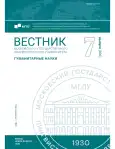The Information Node as a Tool for Implementing Professional Discourse
- Авторлар: Pisarik O.I.1
-
Мекемелер:
- Moscow State Linguistic University
- Шығарылым: № 7(901) (2025)
- Беттер: 107-113
- Бөлім: Linguistics
- URL: https://ogarev-online.ru/2542-2197/article/view/303328
- ID: 303328
Дәйексөз келтіру
Толық мәтін
Аннотация
The aim of the study is to develop and substantiate a structure of the information node as a tool for implementing professional discourse in the field of construction. The research material consists of texts from the sub-language of construction in Russian and English. The study distinguishes between the concepts of institutional and professional discourse, as well as professional sub-language; it clarifies the specific features of construction discourse as a complex multi-code formation. The necessity of introducing the information node is substantiated for the effective representation of terminological information, taking into account the genre, syntactic, and contextual characteristics of professional communication. The main components of the information node are identified, and its capabilities for creating semantic maps, digital lexicographic products, and ontological resources are demonstrated. The study concludes that the information node has high practical value for the study and development of professional discourses in the digital age.
Авторлар туралы
Oxana Pisarik
Moscow State Linguistic University
Хат алмасуға жауапты Автор.
Email: ksyfrolova93@gmail.com
Junior Research Assistant, Laboratory for Fundamental and Applied Issues of Virtual Education
РесейӘдебиет тізімі
- Gorozhanov, A. I. (2025). Online resource of linguistic characteristics of literary works: key parameters and development technology. Philology. Theory & Practice, 1(18), 128–134. doi: 10.30853/phil20250019. EDN WWCZEL. (In Russ.)
- Kondrashina, T. V., Mosina, M. A., Smirnova, I. V. (2024). Formation of infographic literacy in the process of learning a foreign language at a technical university. Pedagogical Education in Russia, 4, 198–204. EDN TCTSNY. (In Russ.)
- Soloveva, R. A. (2022). Problems and prospects of distance learning development as a relevant form of students’ professional training. Vestnik of North-Eastern Federal University. Pedagogics. Psychology. Philosophy, 4(28), 74–82. EDN MUVJLL. (In Russ.)
- Gorozhanov, A. I. (2024). Training future foreign language teachers to work in a virtual learning environment (using a teaching manual as an example). Vestnik of Moscow State Linguistic University. Education and teaching, 1(850), 38–43. EDN MXVJJG. (In Russ.)
- Bryzgalova, O. E., Armashhevskaya, O. V. (2022). Online resource as a tool for preventive measures in providing medical care to women during the COVID-19 pandemic. Obstetrics and Gynecology, 1, 113–121. doi: 10.18565/aig.2022.1.113-121. EDN XHKCHG. (In Russ.)
- Gorozhanov, A. I. (2022). Experimental database modelling of a balanced linguistic corpus. Philology. Theory & Practice, 15(10), 3382–3386. doi: 10.30853/phil20220563. EDN JHBAVG. (In Russ.)
- Karasik, V. I. (2002). Language circle: personality, concepts, discourse. Volgograd: Peremena. (In Russ.)
- Karasik, V. I. (2024). Professional discourse in the digital age. In Radbil', T. B. (Ed.), Diskursivnye praktiki v tsifrovuyu epokhu: traditsii i innovatsii (pp. 110–120): Proceedings of the International scientific conference, Nizhniy Novgorod, 2024, April 4–5. Nizhniy Novgorod: Lobachevsky State University of Nizhny Novgorod. EDN OWMNNC. (In Russ.)
- Pisarik, O. I. (2020). Emergence and correlation of the concepts “sublanguage” and “language for specific purposes”. Modern Pedagogical Education, 6, 183–187. EDN UHPMHD. (In Russ.)
- Pisarik, O. I., Gorozhanov, A. I. (2021). Share of English professional sublanguage in educational texts for students of construction specialities. Philology. Theory & Practice, 3(14), 928–932. doi: 10.30853/phil210082. EDN CIRARX. (In Russ.)
- Simonenko, M. A. (2009). Architectural metaphor in language and speech: PhD thesis in Philology. Kursk. (In Russ.)
- Kazakova, E. V., Frolova, O. V. (2010). Onimy kak element diskursa stroitel’stva i arkhitektury = Onyms as an element of construction and architectural discourse. Vestnik MGSU, 4–5, 85–90. EDN RTUJLX. (In Russ.)
- Petrova, L. A. (2015). Arkhitekturno-stroitel’nyy diskurs kak samostoyatel’nyy ob”ekt lingvisticheskogo rassmotreniya = Architectural and construction discourse as an independent object of linguistic analysis. Eurasion Union of Scientists (ESU). Philology, 3(12), 69–71. (In Russ.)
- Varnavskaya, E. V., Varnavskiy, V. S. (2016). Natsional’no-spetsificheskie kharakteristiki terminologicheskoy leksiki stroitel’nogo diskursa = National-specific characteristics of terminological vocabulary in construction discourse. Crede Experto: transport, society, education, language, 2, 88–96. EDN WAQOYD. (In Russ.)
- Kositskaya, F. L., Zaitseva, I. E. (2015). Architectural discourse and its genres in professional communication (based on the French language). Tomsk State University Journal, 4(157), 142–147. EDN TRJYJL. (In Russ.)
- Beylinson, L. S. (2009). Professional discourse: features, functions, norms (based on speech therapy communicative practice): PhD thesis in Philology. Volgograd. (In Russ.)
- Evtushenko, O. A. (2019). Administrative discourse: types, subjects, dynamics: PhD thesis in Philology. Maikop. (In Russ.)
- Shmeleva, T. V. (2007). Zhanrovedenie? Genristika? Genologiya? = Genre studies? Generistics? Genology? In Sedov, K. F. (Ed.), Antologiya rechevykh zhanrov: povsednevnaya kommunikatsiya (pp. 62–67). Moscow: Labirint. (In Russ.)
- Golovanova, E. I. (2013). Professional’nyy diskurs, subdiskurs, zhanr professional’noy kommunikatsii: sootnoshenie ponyatiy = Professional discourse, subdiscourse, genre of professional communication: correlation of concepts. Bulletin of Chelyabinsk State University, 1(292), 32–35. EDN PVPFPX. (In Russ.)
- Cormen, T. H., Leiserson, C. E., Rivest, R. L., Stein, C. (2001). Introduction to Algorithms. 2nd ed. Cambridge, MA: The MIT Press.
- Pisarik, O. I. (2021). Principles of developing a database of sublanguage in the field of “construction”. Vestnik of Moscow State Linguistic University. Humanities, 5(847), 150–160. doi: 10.52070/2542-2197_2021_5_847_150. EDN RKPNSU. (In Russ.)
Қосымша файлдар










